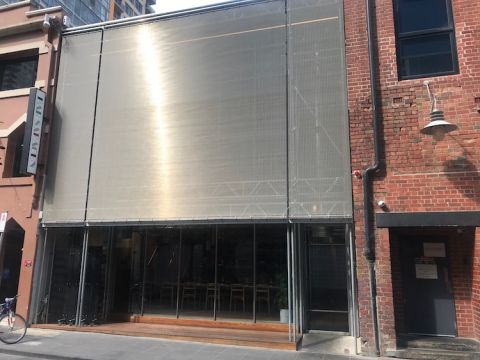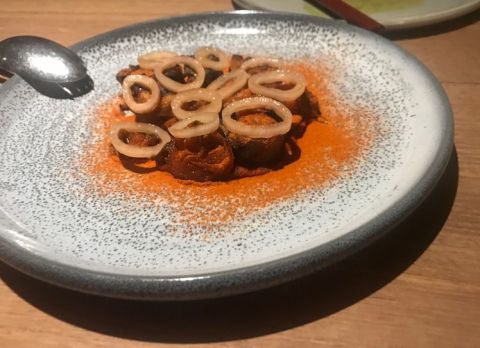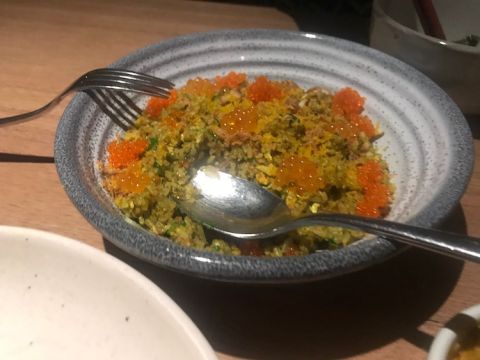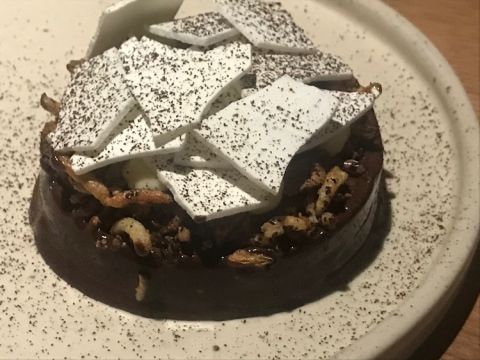First of all is Sunda's name, which refers to the prehistoric landmass that once linked Malaysia, Indonesia and Singapore and obviously provides the vast culinary inspiration for its chef, Khanh Ngyuen, and his team.
Ngyuen himself comes from an unusual background. Born in Sydney to Vietnamese parents, he cooked in several of that city’s top restaurants before cooking with René Redzepi when he brought his Noma restaurant from Copenhagen to Sydney in 2016. Redzepi was to open Nguyen’s eyes to the beauty of native Australian produce.
Then there is the restaurant’s most unusual background and structure.
Sunda was a car park, an empty lot sandwiched between the ever-busy Longrain restaurant and the Bar Saracen, a space that was to prove challenging because it lacks any foundations.
The space appealed, however, to Adi Halim, the wealthy Indonesian owner of the 19th-century Hotel Windsor nearby, who was looking for an independent restaurant that would appeal to the city’s younger diners. In conjunction with architect Kerstin Thompson, he has produced a restaurant with a most unusual interior.
The building is held together by a sequence of scaffolding poles. These are interlinked at the ground floor and first floor by some particularly solid wooden panels. The structure has obviously been approved and is continually tested by the authorities every month, according to Kosta Kalogiannis, the restaurant’s assiduous general manager.
The scaffolding provides a permanent showcase for the theatre that is at the heart of every good restaurant. There is an open kitchen in front of two large communal tables that run across the width of the building. Behind this is a steep staircase that leads to a sequence of smaller tables. The whole is dramatic, surprising and effective.
The only drawbacks are the acoustics, and (a common complaint in this city that is otherwise exciting to eat in) the menu design. Why do so many chefs and restaurateurs choose a typeface that can best be described as tiny and in this instance without a single capital letter? And, of course, they use only two colours at Sunda, a faded black on a faded grey paper.
Once our eyes had grown accustomed to the typeface – and I was continually distracted by the action of the chefs behind me – there was some consternation at the menu. A few of the items were obviously well known: those predominantly to the left of each line, such as raw scallops, veal tartare, barramundi (Asian sea bass), and a pork cutlet. But what about all those ingredients to the right, in many ways the determining factors in how any dish will taste? Kakadu plum? Bush tomato? Belacan butter? And what is a sunrise lime satay?
The answer is that in Nguyen’s hands, and those of the rest of his team that includes Malays, Chinese, Vietnamese and even the odd New Zealander, everyone will be surprised and nobody will be disappointed. The food that emanates from Sunda’s kitchen is astonishingly good.
The three of us, encouraged by our waiter to share, chose dishes that encompassed most of what the term Sunda would have covered. A roti, pure India, which was made from buttermilk to give it a really rich flavour, was paired with a Vegemite relish, pure Australia. The thin, raw scallops, also shown above, along with a corner of the challenging menu, came topped with lemon aspen, an acidic bush fruit from Queensland, and a sweet and sour tamarind sauce. Best of all, to look at and to eat, was the octopus from Fremantle in Western Australia, whose red flesh was made even more so by the topping of a sauce of indigenous bush tomato (immediately below).
Encouraged by the freshness of a bottle of Quealy Friulano 2017 made in the nearby Mornington Peninsula (AU$64) from a wine list written in the same minuscule typeface as the menu, we progressed to three main courses that showed the same diversity of approach and ingredients. A fillet of barramundi (above) topped with the unlikely but very appetising combination of lap cheong, or Chinese sausage, and betel leaf, wild pepper; an excellent rendition of smoked aubergine and the native Davidson’s plum; and, the most mundane of all, a pork cutlet enlivened by rainforest tamarind. A side dish of herb-fried rice was made special indeed by the crunchy addition of lemon myrtle and bottarga, mullet roe (below).
Nguyen’s palate is particularly attuned to desserts and, happily, we ordered each of the three on offer. A jasmine rice cream was luscious, made even more so by the addition of strawberry gum; a honeycomb cake reminded me of eating a Crunchie bar as a boy; but the most impressive, and the most arresting, was simply described as sunda pav.
This round chocolate dessert, enlivened by Vietnamese coffee, came with wattle seed, the edible seed of the Australian acacia, and coconut. But its resemblance to this country’s national dessert came via the small pieces of meringue on the top that were, I am told, intended to mimic the pieces of the tectonic plates that had led to the break-up of Sunda many years ago.
Do go, but don’t forget your iPhone: for its camera and, particularly, its torch.
Sunda 18 Punch Lane, Melbourne, 3000 Victoria, Australia; tel +61 (0)3 9654 8190




















